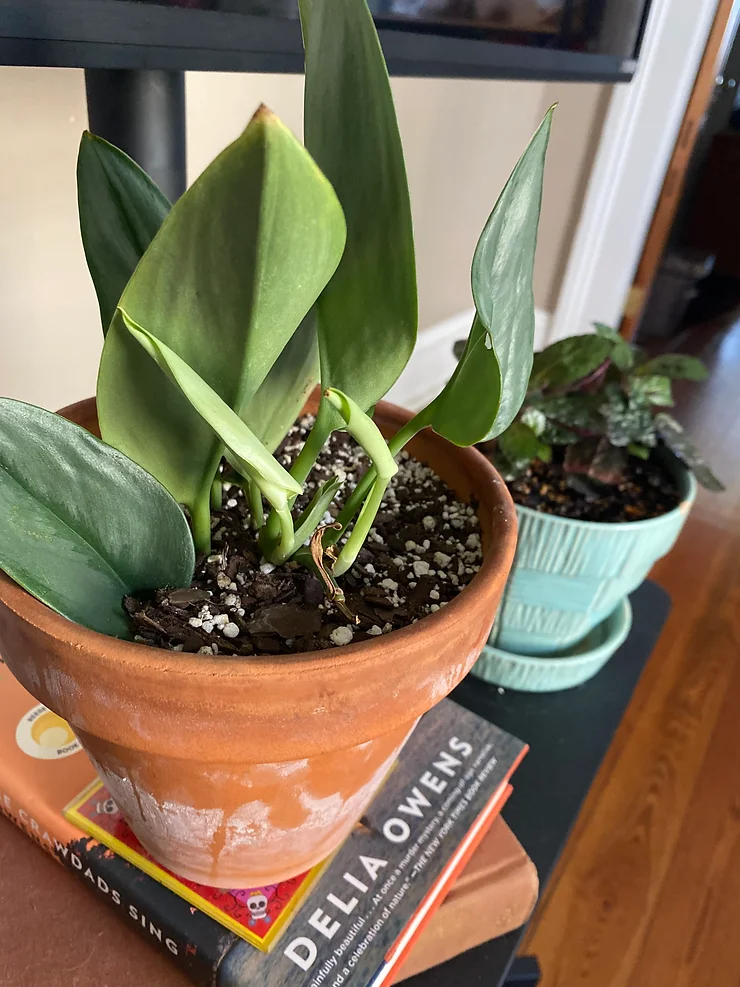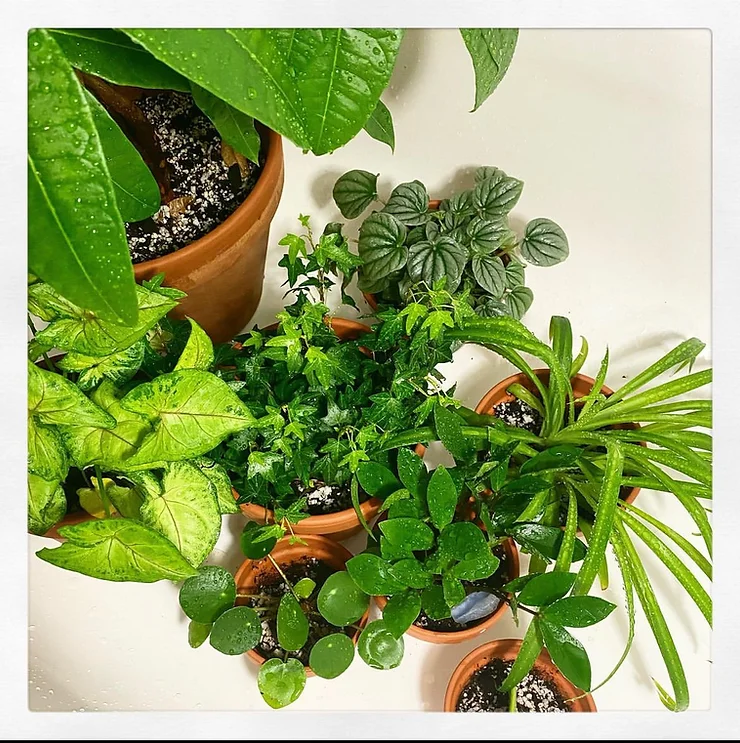The Quick Start Guide
for thriving House Plants

Life Just got a little greener
Plants are integrated into almost everything we as humans encounter, from cleaning the air to mental stimulation to feeding ourselves and our food. Inviting nature indoors is proven to uplift mood, sharpen attention, increase production, and imbue a better outlook on life. When treated with care and respect, houseplants vastly improve our quality of life.
Plant varieties are used in traditional and Western medicine, provide oxygen for the planet, and are as vastly different as humans. Plants have an everlasting symbiotic relationship with humans that we’d do well not to take for granted. Plants, flowers, and even algae elicit powerful emotions in humans and thus deserve careful and compassionate care.
While respecting and caring for plants can be a sacred experience, getting too far in the weeds (pun intended) can take the magic out of plant ownership. Don’t let a couple (or a lot) of failed attempts deter you from the joy of houseplants. While they are living, breathing beings, they are way more forgiving than puppies or children. Give yourself some slack, take time to learn more about your plants, and never stop trying.
Why get a houseplant?
Life comes at us hard, fast, and sometimes all at once, so why should we add another thing to consider and care for? The answer is the very same reason. Slowing down and appreciating the world around us is often so far down our to-do list that we forget we need that time to thrive rather than simply survive. Besides the scientifically based evidence that plants boost our moods, something as simple as a weekly leaf inspection can ground us in things outside the daily grind.
Food for the uninspired. Nature inspires poets, painters, and deep thinkers and is held in the highest regard by creatives. While beauty is enough to strike one speechless, even the most left-brained person can appreciate the process. Mathematical spirals from new leaves, chemical processes from soil PH and fertilizers, and environment engineering are some ways the plant process lends itself to an engaging experience for every proficiency level.
TLDR: They’re good for you and fun!

Houseplant
Houseplants are simply plants you’ve decided to place indoors. Some are more suitable for the home environment, but technically any plant can become a houseplant.
Cacti
Cacti and succulents, while different types of plants, require similar maintenance. Many of these plants prefer sunny and arid environments and quickly deteriorate around excess water.
Tropical
Tropicals are a favorite in the houseplants world. They are versitle and their natural environment is most easily recreated indoors. They usually prefer high humidity, moderate watering, and bright, indirect light.
Aquatic
Aquatic plants grow mostly in freshwater and many can be emersed or submerged. They come in wide varieties like moss, floaters, and buried. Some even flower! These make excellent additions to aquariums, ponds, and display jars.
Herb
Herbs are plants with medicinal or culinary benefits. Unlike spices, herbs are the delicate leafy or petal parts of the plant. They are generally easy to grow and most are considered to be invasive plants or “weeds” when left to their own devices.
But where to begin...
Congratulations on your plant parenthood journey, we’re glad you’re here! The sheer number of houseplants out there can become overwhelming for beginners, but it doesn’t have to be. The best way to ensure better success is to start with common houseplants. They are common for a reason! These plants are easily adaptable, generally pest resiliant, and will make even the blackest of thumbs feel a little greener. Our favorites are pothos, philodendrons, monsteras, and succulents.
DO:
- Look for vines
- Vines are some of the easiest plants to care for and come in a vast variety.
- Look for plants with thick, dark leaves
- Hearty leaves often lend themselves to hearty plants
- Inspect the plant
- Check for pests, diseases, or poor growth patterns
- Evaluate your environment and find a plant that matches
- Get a plant for the environment, not the other way around as this will save you a lot of headache
- Start cheap
- Cheaper often equals easier plus it’s less of a blow should something go wrong
Don't:
- Go on just astetics
- Pretty leaves can be deceivingly difficult as they require specialized care to keep the color or contend with their delicateness.
- Rely solely on big box stores
- Chain stores can be a source for inexpensive, common plants, just be cautious as they are not usually inspected as carefully and may have damage, pests, or diseases that would usually be treated at smaller venues.
- Start big
- More plant, more problem! Start with one or two 4-6 inch plants so you can learn the plant process in a more controlled manner.
- Be afraid to ask questions!
- Stop in your local plant shop and talk with them about your exact needs. We promise they are as excited to talk plants as we are!
foundations
You’ve taken the plunge and purchased your very first (or second or third) houseplant…now what? First, hell yeah! You’ve already taken the most important step. The biggest mistakes beginner plant parents make are due to three things: water, light, and environment. Once these hurdles are mastered it becomes a case of nuance and finesse to serve the individual needs of each plant. Plant care is pretty simple and straightforward, just pay attention and love on them and they’ll tell you everything you need to know.
Your new housemate will be sensitive when you first bring them to your home or office, so give them a week or so to settle in. Avoid placing them directly into a window, next to a draft (like an a/c vent), in an extremely dark area, or next to any other plants you already have. Check on it daily, looking for bugs, soil drainage, and reaction to light and water. If you’re happy with the results after a week find your plant is ready for its permanant home if it’s not there already.

Light
Lighting for houseplants is a little more straight forward than our outdoor friends as they have very similiar needs. We need to remember that all houseplants came from nature at one point or another, so we need to replicate that indoors. Though some plants are labeled for low light, very few will thrive when thrown in a corner. Conversely, most indoor plants are not suited for hours of direct heat and sunlight. The happy medium lies in bright, filtered or indirect light. This looks like a south-facing window with a sheer curtain or a west facing window behind a shady tree. No matter the light conditions in your home or office, give your plant some time to adjust before you make big changes to its environment.
Water
Over and under watering is one of the most common first-time plant parent mistakes because it’s so easy to do. The easiest way to combat this is to schedule your watering. Establish the cadence after the first month in it’s permanant home; you’ll need to consider the plant’s pot (clay pots wick moisture while plastic holds it in), proximity to heat, and soil quality. The alternative is intuitive watering where you inspect the plant daily and manually check is water is needed. You can do this by sticking your finger down in the pot and feeling the soil, OR sticking a wooden chopstick in the pot then placing it next to the pot to see where the moisture ends. A general rule of thumb is water when the moisture level is 2 inches or more beneath the lip of the pot.


Environment
Ideally, we want to recreate the environment the plant came from. This means understanding the soil type, light, and humidity requirements at least. Learning about your plant’s natural environment helps you to understand plant care more intuitively by understanding the roots (pun intended) of plant needs. This sets you up to be prepared for any plants that comes from that region or environment.
For example, cacti will do best in a south-facing window and are allowed to dry out completely. They will suffer if left in a dark, damp bathroom. Conversely, tropical plants originating in the jungle will shrivel and die if given direct sunlight and irregular watering. Most common houseplants are adaptable to indoor conditions—just make you pay attention to the nuances of each plant.
At the end of the day...
Just have fun yall. While plants are sacred and sometimes fragile beings, they’re way more forgiving than a puppy. And quieter. A good rule of thumb is when a plant looks like it’s going downhill, cut it and propagate it before it dies completely. Then just try again. And again. And again. Then, if you’re stubborn like us, you’ll have a grave yard of calatheas lining your compost. All that’s just to say, plants regenerate and will out live mankind. Start with some common plants and have fun experimenting–that’s the best advice we got.



